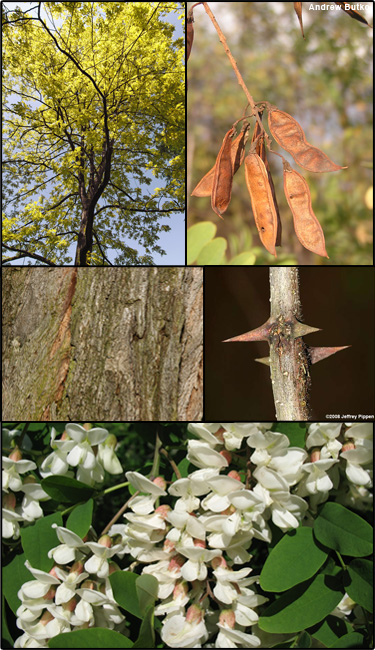Black locust (Robinia pseudoacacia)
 Synonyms: Robinia pseudoacacia L. f. inermis, Robinia pseudoacacia L. var. pyramidalis, Robinia pseudoacacia L. var. rectissima
Synonyms: Robinia pseudoacacia L. f. inermis, Robinia pseudoacacia L. var. pyramidalis, Robinia pseudoacacia L. var. rectissimaCommon Names: False acacia, Yellow locust
Description: The nitrogen fixing capacity of this species may alter soil chemistry and subsequent nutrient cycling of forest systems.
Habit: Deciduous medium tree ranging in height from 12-25 m (40-82 ft) and 30-60 cm (12-24 in) in diameter; crown narrow, open, irregular with contorted branches.
Leaves: Alternate, pinnately compound with 7-21 leaflets per leaf, leaf 20-35 cm (8-14 in) long, ovate leaflets 2-5 cm (1-2 in) long and about half as wide, thin with smooth margins, hairless, dull bluish green above paler beneath, turning yellowish brown in fall.
Stems: Twigs puberulent, becoming smooth, green to reddish brown, with zigzag shape and two spines at each node; bark is thick, tan to gray-brown, deeply furrowed; inner bark orange.
Flowers: White in color, 5 petals, pea-like, very fragrant, raceme of 10-25 on a thin dangling pedicel; blooms May through June.
Fruit and seeds: Seed pod, form in the fall but persist over winter, smooth, dark-brown in color, flat, contains 4-8 seeds.
Habitat: Very shade intolerant; can grow in many soil types except those with a high water table; formerly widely planted in Michigan and now found colonizing old fields, prairies, disturbed forests and woodlands.
Reproduction: By seed. Also sprouts easily from roots and forms natural clones.
Similar species: Native honey locust (Gleditsia triacanthos) has smaller, southern native bristly locust (Robinia hispida) is shrublike with brushlike hairs on stems and fruit; False indigo (Amorpha fruitcosa) shrublike with smaller leaves.
Monitoring and rapid response: Monitor prairies and woodland edges and paths, particularly on well-drained soils; most visible in May and June while in flower but bark is distinctive year-round. Because this species is strongly clonal, all stems in a clone must be treated. Cutting and girdling stimulate sprouting unless cut stumps are treated with herbicide. Basal bark treatment is also effective. Fire stimulates resprouting; mowing stimulates germination of the (black locust) seed bank. This species is difficult to control, research control options thoroughly. Credits: The Michigan Natural Features Inventory (MNFI) has partnered with MISIN to provide the information in this fact sheet. Species images and/or information were used with permission from "A Field Identification Guide to Invasive Plants in Michigan's Natural Communities" and "A Field Guide to Invasive Plants of Aquatic and Wetland Habitats for Michigan.
Common Name: | Black locust |
Scientific Name: | Robinia pseudoacacia |
Family: | Fabaceae (Pea) |
Duration: | Perennial |
Habit: | Trees |
USDA Symbol: | ROPS |
 View Species Course |
|
